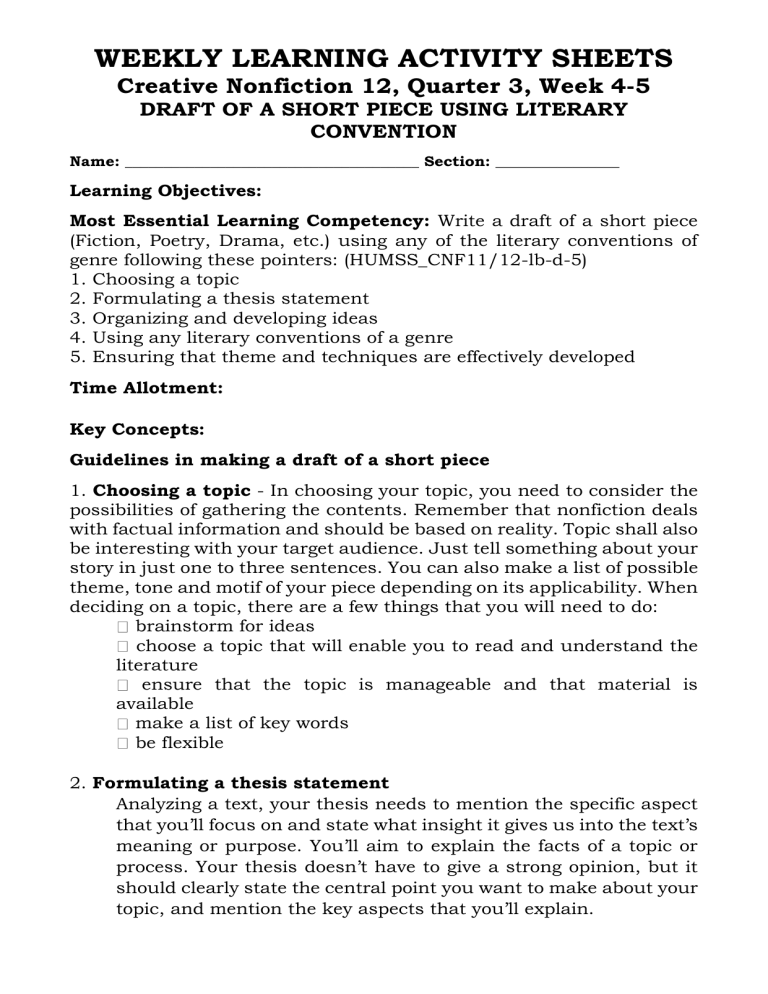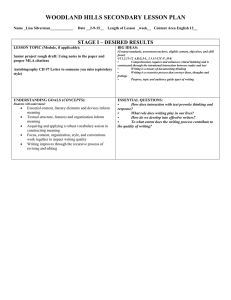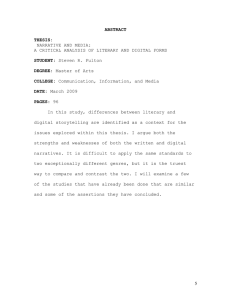
WEEKLY LEARNING ACTIVITY SHEETS Creative Nonfiction 12, Quarter 3, Week 4-5 DRAFT OF A SHORT PIECE USING LITERARY CONVENTION Name: ______________________________________ Section: ________________ Learning Objectives: Most Essential Learning Competency: Write a draft of a short piece (Fiction, Poetry, Drama, etc.) using any of the literary conventions of genre following these pointers: (HUMSS_CNF11/12-lb-d-5) 1. Choosing a topic 2. Formulating a thesis statement 3. Organizing and developing ideas 4. Using any literary conventions of a genre 5. Ensuring that theme and techniques are effectively developed Time Allotment: Key Concepts: Guidelines in making a draft of a short piece 1. Choosing a topic - In choosing your topic, you need to consider the possibilities of gathering the contents. Remember that nonfiction deals with factual information and should be based on reality. Topic shall also be interesting with your target audience. Just tell something about your story in just one to three sentences. You can also make a list of possible theme, tone and motif of your piece depending on its applicability. When deciding on a topic, there are a few things that you will need to do: brainstorm for ideas choose a topic that will enable you to read and understand the literature ensure that the topic is manageable and that material is available make a list of key words be flexible 2. Formulating a thesis statement Analyzing a text, your thesis needs to mention the specific aspect that you’ll focus on and state what insight it gives us into the text’s meaning or purpose. You’ll aim to explain the facts of a topic or process. Your thesis doesn’t have to give a strong opinion, but it should clearly state the central point you want to make about your topic, and mention the key aspects that you’ll explain. 3. Organize ideas Chronological Order • What it is: This is a very common way to organize ideas as a writer or storyteller that basically involves dishing out ideas or details in order of time, first to last. • When to use it: It is often used in expository writing (narrative that informs or explains) – particularly when describing an event or series of events. • Example: Think about when you were a kid and trying to explain to the principal why you shouldn’t be left in detention until the end of time. Yup! You described the events carefully and in order, because that’s how you make sure your listener/reader understands the context and details of a narrative. • Transition words are important with every framework you use, to help your readers navigate the process smoothly. In the chronological framework, some commonly used transitional word and phrases are: first, then, next, last, finally, etc. 4. Using any literary conventions of a genre Literary conventions are defining features of particular literary genres, such as the novel, short story, ballad, sonnet, and play. 5. Ensuring that theme and technique are effectively developed The purpose behind your writing will shape how you develop your theme in the piece. There are numerous purposes as to why someone writes. Understanding who your audience is lets you determine which themes are appropriate to your audience. Exercises / Activities: Activity 1: Write a Free verse poem by completing the blanks below. Example: Baby Sensitive, polite, simple and amiable Sister of Philip John, Kit Jan and Jay Lover of food, family and friends Who feels happy, sad and lively Who needs parent’s attention, love and care Who gives smiling faces, headaches and determination to success Who fears of heights, being left behind and dying Resident of Halapitan, San Fernando, Bukidnon Albuna Line 1: Write Your First Name ______________________________ Line 2: Write 3 adjectives that describes yourself ____________________ Line 3: Write daughter of/Son of _____________________________________________ Line 4: Write 3 emotions ________________________________________________ Line 5: Write 3 things you need ________________________________________________ Line 6. Write 3 things you give ________________________________________________ Line 7: Write 3 things you fear the most __________________________________________ Line 8: Write your Address _______________________________________________________ Line 9: Write your Last Name ________________________ Activity 2: Create a draft of a short story. Follow the guidelines about making a draft of a short piece above. Rubrics in making a draft of a short piece Criteri a Clarit y of idea Appropriat e choice of literary element Points 5 5 Appropriat Effective e combinatio use of the n of element the idea and the chosen literary element 5 5 Total Point s Activity 3: Write the final output of your short story. Reflection: Directions: Write a reflective learning about what you have learned in writing a draft of a short piece using any of the literary conventions of genre by answering the questions inside the box. You may express your answers in a more critical and creative presentation of your great learning. Have fun and enjoy! WHAT I LIKED THE MOST ABOUT THE LESSON • • • WHAT I NEED TO IMPROVE IN UNDERSTANDING THE LESSON • • • WHAT I WANT TO LEARN CONNECTED TO THE LESSON • • • Reference for Learners: Writing Creative Nonfiction”. (2019). Retrieved August 16, 2020 from https:// davehood59.wordpress.com/2010/02/17/writing-creativenonfiction/ “Writing Prompts for Analyzing Nonfiction”. Retrieved August 17, 2020 from https:// owl.purdue.edu/owl/teacher_and_tutor_resources/teaching_ resources/ remote_teaching_resources/writing_prompts_for_analyzing_n onfiction.html Writers: RUBY S. BULATIN HAZEL H. MONTEDERAMOS MARILOU C. CASTRO IMARC FERNAND C. VERGA School/Station: Agusan National High School-SHS Division: CBD-I Email address: ruby.bulatin001@deped.gov.ph marilou.castro007@deped.gov.ph Reviewers: DOLYNESSA J. GALEON HUMSS C Group Head AMALIA B. RINGOR Track Head RUTH A. CASTROMAYOR Principal IV Assistant Principal – SHS ISRAEL B. REVECHE, PhD. EPS-Values Division SHS Coordinator







